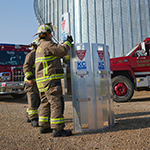Controlling grain dust explosions
Grain dust and ignition sources must be controlled to prevent grain dust explosions.
This article is courtesy of the World Grain magazine.
Written by Paul Stevenson, Sr. Risk Management Consultant, Nationwide
People in the grain industry know the causes and effects of grain dust explosions and how deadly they can be. But for a variety of reasons, namely operations tempo and the thought that "it will never happen to us," some grain operators and management do not spend the time and devote resources to prevention and reducing risk.
Most grain dust explosions in grain elevators happen within the bucket elevator or leg. Grain is flowing into the facility by truck or railcar. A heated bearing or a spark is produced inside the leg and a primary explosion rocks the facility. Usually a primary explosion is not the explosion that causes the most damage or kills elevator employees. The secondary explosion is the deadly killer and produces the most damage to the facility.
There are three elements to a grain dust explosion. First, there must be grain dust. Grain dust in a leg casing and throughout the facility is managed by keeping grain dust in suspension to a minimum. Second, there must be a confined space. Leg casings and even certain parts of an upright concrete elevator can be considered confined spaces. Third, there must be a spark or heat source to ignite the fuel.
How does an explosion happen? First, there is a heat source inside the leg casing, perhaps a dry and heated bearing. Grain dust builds in the leg casing until the heat source or spark ignites the dust inside the leg casing. The primary explosion in the leg casing rocks the facility but is mainly controlled inside the casing. In most cases, buckets elevators were built with "blast" panels installed to relieve explosions. Now that the facility has been rocked by the primary explosion, fugitive grain dust on ledges, equipment, spouts, floors, etc., is shaken loose and put into suspension inside the upright concrete. Once the "blast" panels blow, heat and fire escape into headhouses, basement tunnels and gallery floors. Since dust is already in suspension and there is heat/fire, the secondary explosions start and do not stop until all fugitive grain dust has been utilized.
How do you stop an explosion from happening? The simple answer is we need to remove one of the three elements mentioned above.
Controlling grain dust
If you control grain dust, you eliminate the fuel source. There are several methods to reduce the fuel source. However, elevator operators must be motivated to clean and maintain effective controls and management must be committed to installing effective controls and eliminating the risk of an explosion. Remember that any method to control the dust costs time and money.
Effective use of food grade mineral oil is a great example of controlling grain dust. Food grade mineral oil is approved for use in commodity grain. It is applied to grain at the receiving pit (chute to leg). Grain dust is attracted to the grain, thus removing suspended grain dust. Mineral oil systems are installed and are monthly/annually calibrated to ensure proper application rates. Application rates vary with the type of upright concrete storage. However, a good rule of thumb would be 1 gallon to 1,000 bushels.
In many cases, companies are applying food grade mineral oil at in-house belts or enclosed conveyors for the frequent turning of grain. This is strongly recommended for wheat houses where the turning of grain is an everyday occurrence. Once again, the application rate is 1 gallon to 1,000 bushels turned.
While it is true that food grade mineral oil prices have greatly increased in the last 10 years, the users of food grade mineral oil are amazed at the effecti1.e results. Housekeeping costs (personnel pushing brooms and cleaning) are dramatically reduced. In most cases, dust control equipment (cyclones and dust collectors) has been turned off due to the proper installation and calibration of food grade mineral oil systems.
It is strongly recommended that food grade mineral oil systems are purchased by qualified equipment dealers. Equipment installation can be tricky. Equipment consists of a pump, tank with sight gauge, piping, spray nozzles, electrical, and could include in-line heaters depending on geographical areas. Users should strongly consider having an external third party install the equipment and perform first calibration.
The dependent use of dust collection systems (cyclones and bag houses) is outdated. In the late 1990s, it became increasingly difficult to get rid of collected dust in the United States. Markets for grain dust almost went to zero in the Midwest. Therefore, it seems more practical that dust be kept into the grain stream by food grade mineral oil.
With the use of food grade mineral oil systems, facilities still need to sweep and control dust inside an upright concrete elevator. Housekeeping schedules should be developed and monitored closely. All areas of the elevator must be recognized as contributing to a dust explosion. Each area must be cleaned, depending on usage, and documented. Any dust that accumulates on ledges, conveyors, floors, spouting, equipment, etc., would strongly contribute to secondary dust explosions and must be addressed daily.
Dust leaks from equipment and spouts are the main contributor of dust accumulated in housekeeping areas. Elevator operators have to be diligent in finding and fixing leaks. Management must be advised of equipment that can't be maintained in a proper housekeeping schedule and equipment must be replaced. Short-term fixes can be the use of aluminum and duct tape. However, this should only be considered a short-term fix until new equipment is installed. Continuous review of equipment during operations by operators is a must.
As an outside consultant to the grain handling industry, it is amazing to me that managers and operators would rather spend the time in manpower to continuously clean an area instead of spending a short amount of time and money to fix a small leak and not clean the area again for quite some time. Operators must up-channel the requirements for capital improvements/maintenance improvements to senior management and senior management must react with on-time fixes to real problems. The acceptable amount of dust accumulations allowed by OSHA in the 29 CFR 1910.272 standard is too much grain dust. Dust accumulations in primary housekeeping areas should be zero and can be achieved with calibrated mineral oil application, housekeeping and eliminating dust leaks on equipment.
Lastly, inspections of housekeeping/dust accumulations are a must. Some facilities hire an outside third-party inspector to perform "no notice" inspections of housekeeping. Reports are documented and results are shared company-wide. Expectations for success are strongly conveyed from management to operators. "No Notice" inspections keep the location on its game by never knowing when the auditor will show and allows for an "outside" set of eyes to examine possible weaknesses. Benchmarking can also be performed from one facility to the other.
Confined spaces
There is really not much you can do with confined space.
A bucket elevator will always remain the same size and shape and a headhouse floor for an upright concrete facility will always remain the same size and shape.
Ignition sources
An ignition source can be many things, including but not limited to a heated bearing, a cigarette, hot work, a spark from metal-on-metal contact, bad maintenance practices, electrical issues, etc. So how can we control so many possible ignition sources?
The answer lies within good written programs and dedication from the elevator operators. Every grain facility should be operating with extensive maintenance programs. These programs are designed according to manufactures recommendations to provide service to all equipment within the elevator in a timely manner.
Proper greasing schedules and inspection of bearings significantly reduce the potential for bearings to get hot and become an ignition source. Operators must be diligent in scheduling maintenance and following maintenance schedules, regardless of operations tempo. In addition, elevators must have written programs to address smoking around grain handling facilities, hot work permitting and electrical programs.
Hazard monitoring equipment on upright concrete is a must. It includes hot bearing detectors, rub blocks and sensors to ensure the leg is tracking property. Hazard monitoring equipment must be checked frequently by maintenance or operations employees to ensure alarms work property and have not been previously disconnected. Elevator operators sometimes disconnect these alarms when they feel the system is not working properly.
Inspections should be accomplished several times during the course of a year to see if leg belting has been making contact with rub blocks. If facility equipment has not been reviewed for a long period of time, it is recommended that an outside third party inspects, adjusts and maintains hazard monitoring equipment to ensure it works properly. These devices greatly decrease undetected hot bearing and rub issues (sparks and unnecessary heat) inside the leg casing.
It is strongly recommended that facilities invest money in thermo-graphic studies on a fairly frequent basis to determine hot spots, both electrical and mechanical. Thermo-graphic images show where hot spots are located and can be addressed before they become a larger issue down the road. Typically, thermo-graphics are used for electrical rooms and bearings. Stray and faulty (old or not connected property) electrical systems can easily be a culprit for a grain dust explosion. For the money, this is cheap insurance. There are several companies that provide the service and will document results. Also, facility insurance companies like to see these results.
Risk can be significantly reduced
Can grain dust explosions be eliminated at upright concrete facilities? We can do more to greatly decrease the chances of grain dust explosions. And if we do have an explosion, we can significantly reduce our risk of a "deadly" explosion. With effective food grade mineral oil systems installed, housekeeping and maintenance schedules developed and followed, inspections and corrective actions of dust leaks in conveying systems, and inspections, we attempt to remove one of the three elements required to have an explosion.
By performing the tasks outlined in this article, those risks are significantly reduced. Management has to be supportive and, in most cases, capital expenditures will be required to assist the facility. Management is key in the success and failure of these programs. If management does not endorse a cleaner facility or facilitate the purchase of equipment, then the risk for explosion rises a great deal.

 >
>

 >
>
 >
>